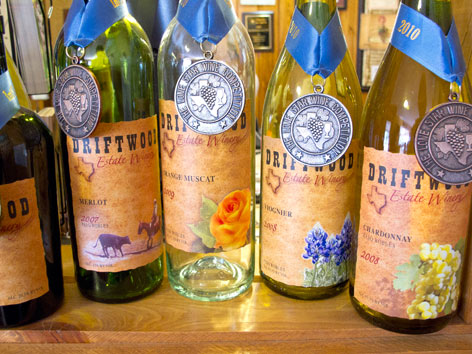Ethiopian Chicken Stew (Doro Wett)
Ethiopia
amantour

guides you to the best local dishes & drinks in
125+ cities. See map now



EYW wants your food photos!

EYW wants your food stories!
Hey guys I am a traveler who loves to explore different places around the world. I often visit outside of Canada, So whenever I have to travel around the world I always book my flight tickets from the... Read more

What: Winemaking in Texas dates back to the 17th century, when Spanish settlers near El Paso, wanting to make sacramental wines, discovered that native Texas grapes worked just fine. Fast-forward to Prohibition, which nearly extinguished the industry for good, and from which the region is still recovering (many counties in Texas are still “dry”). It’s therefore all the more notable that Hill Country, the rugged Central Texas area extending west between Austin and San Antonio, is fast becoming widely known for its wine, which, along with those from elsewhere in the state, are achieving a good deal of recognition in competition.
The Hill Country region itself is the second-largest viticultural area in the U.S., comprising nine million total acres and 63 total wineries, 27 of which are recognized by the Texas Hill Country Wineries (its criteria includes on-site crushing and wine production). In this rolling terrain, where the weather is often unpredictable and summer’s hot and humid climate is akin to that of southern Italy, you will find lots of diverse Mediterranean varietals that perform well in heat—Spain’s Tempranillo, Italy’s Sangiovese, France’s Viognier and Syrah—alongside the mass-market merlots, chardonnays, and cabernets. However, this is still cowboy country, so don’t be surprised by wine names like “Kick Butt Cab” or “Alamo Red” occasionally showing up on your tasting menu. Tuscany in Texas? You be the judge.
Good to know: April through July is perhaps the prettiest time to drive around in Hill Country, thanks to blooming wildflowers and fruit orchards.
Where: While you could easily dedicate a few days to this region, if you’re visiting Austin, you’ll likely day-trip to the wineries nearest the city—those in the towns of Driftwood, Dripping Springs, Spicewood, and perhaps Marble Falls. Fortunately, two of those towns are also home to beloved BBQ joints, making them a rather ideal day excursion. Near the celebrated Salt Lick BBQ—which is BYO, so newly purchased bottles of wine are encouraged!—in Driftwood, about 40 minutes southwest of Austin, we liked Driftwood Estate Winery (4001 Elder Hill Road CR 170, map) for its pretty hilltop location and excellent Viognier, sweet citrusy Orange Muscat, and Sangiovese, its “Texas version of a Super Tuscan wine” ($5 for six tastes). Also in Driftwood, we enjoyed the more modern Duchman Family Winery (13308 FM 150 W, map) and its award-winning Italian-style Texas wines, including its 2008 Dolcetto (which took home a Double Gold award at the prestigious San Francisco International Wine Competition in 2010) and 2009 Vermentino ($10 for six tastes).
Even closer to Austin is the town of Dripping Springs, where you can swing by Solaro Estate’s (13111 Silver Creek Rd., map) Euro-style “Tasting Pavilion” for Tempranillo, Grenache, Mourvedre, and more. If you’re interested in checking out Opie’s Barbecue in Spicewood, you’ll be within striking distance of the lakefront Stone House Vineyard (24350 Haynie Flat Rd., Spicewood, map) and award-winning Spicewood Vineyards (1419 Burnet CR 409, map). Finally, nearby Marble Falls is the home of the “Super Texan” Sangiovese: Flat Creek Estate (24912 Singleton Bend St., map), a winery that placed well in several 2010 wine competitions.
When: Driftwood Estate’s tasting room: daily, 10am-6pm. Contact individual wineries for hours, as they tend to change seasonally.
Good to know: If you’re traveling further toward Fredericksburg, check out the magnificent Becker Vineyards (464 Becker Farms Rd., map) in Stonewall, perhaps the most decorated and recognized of the Hill Country crop. Be forewarned that it’s quite popular, so a weekday visit might be most pleasant.
Alternatively: Groups of two to six can book a wine-tasting tour of three area wineries in a vintage VW bus, courtesy of Vintage Tours of Texas (from $150 per person); you can even schedule a lunch stop along the way, if you choose. If you can’t make it out to the vineyards, you can certainly sample Texas wines in Austin restaurants and wine stores (you’ll have less luck, oddly, in many of the area’s wine bars). Hudson’s on the Bend (3509 Ranch Rd. 620 N, map) has some good locals on its extensive list and offers a five-course (plus dessert) Hill Country tasting menu with local wine pairings for $130; new gastropub Barley Swine (2024 S. Lamar Blvd., map) likewise carries a few area wines. For more variety, the Austin Wine Merchant (512 W. 6th St., map) downtown is a great shop for Texas bottles.
©2025 Eat Your World, LLC - All Rights Reserved